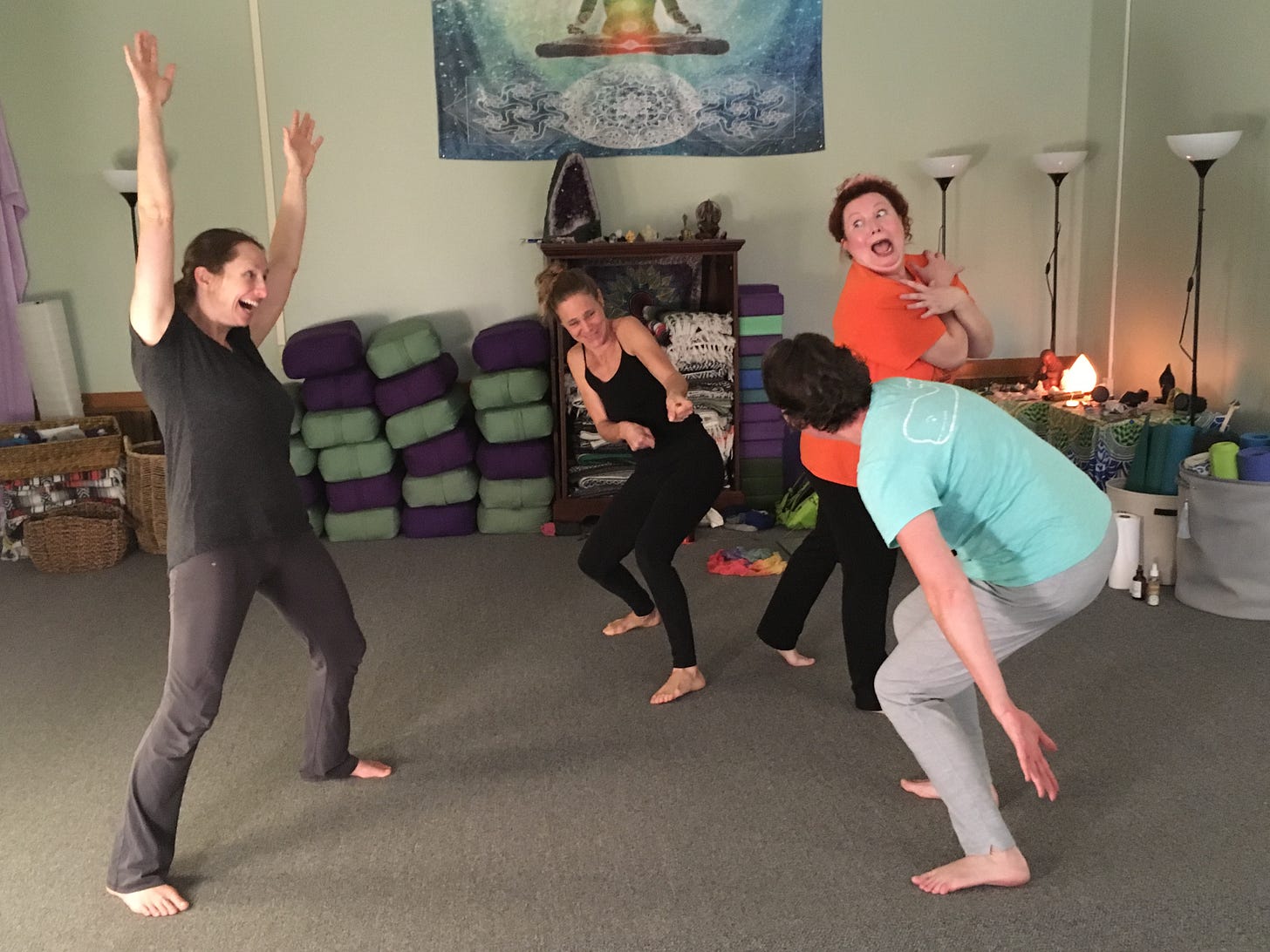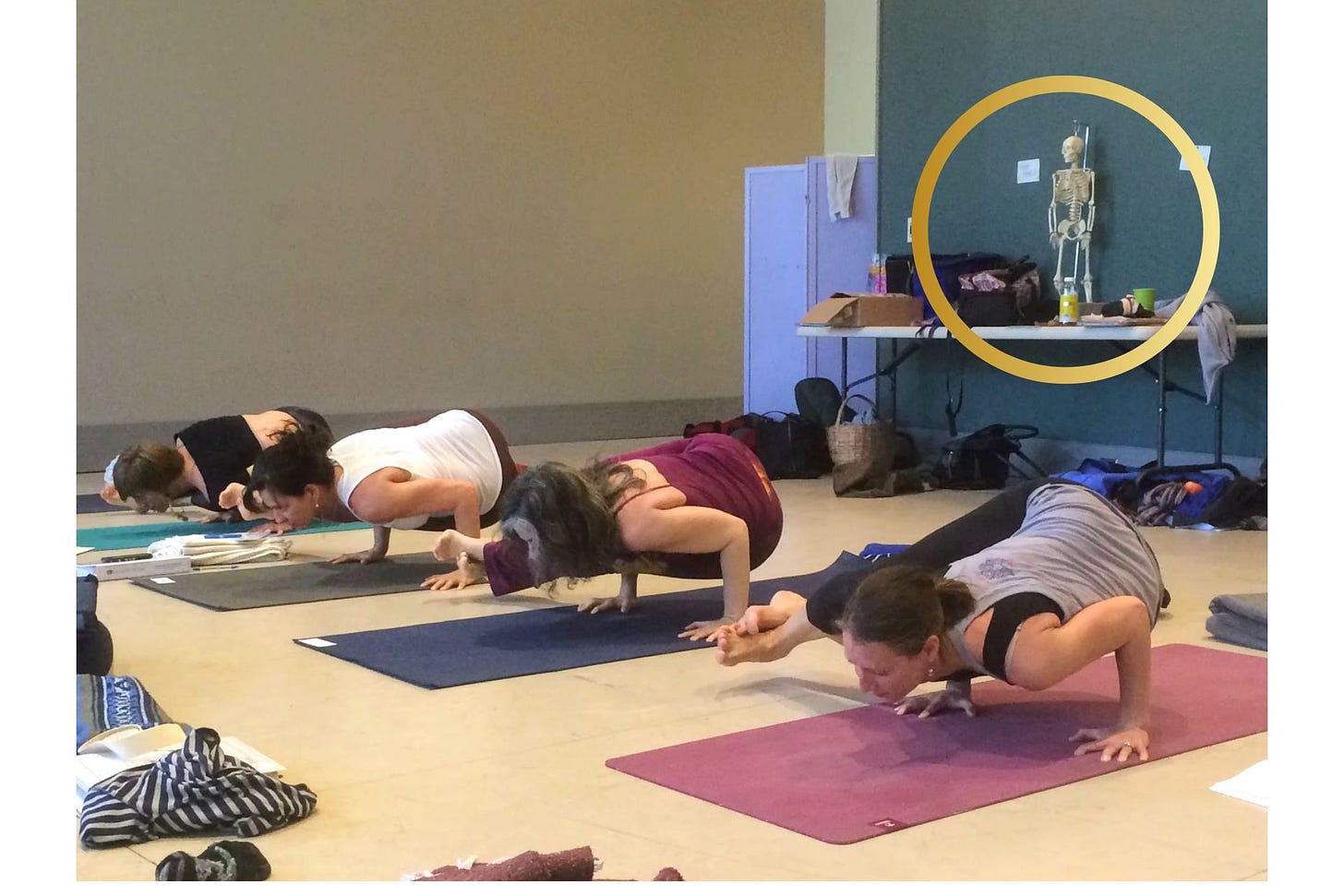I’m a junior in college, sitting in Theatre Improvisation 101, waiting for the first class to start. I’m so nervous I can’t actually breathe normally – respiration is coming in little fits as I sporadically remember that oxygen is important. All I can think about is how I’m going to have to get up on stage in a few minutes and create theatre out of thin air… Ah yes, right. Breathe.
The professor appears in front of us in funky, jewel-toned, flowing clothes and twinkling eyes. She seems filled with mischievous energy yet somehow utterly relaxed.
I want to be like her.
Instead, I’m fabricating elaborate excuses that will get me swiftly out the door: “I just realized I’m in the wrong class,” “I think I may have food poisoning,” or the beautifully vague, unassailable, and thus ever-popular, “something came up.”
I don’t utter any of these, because I’m not good at lying. I’m not sick, nothing but existential dread has come up, and this is the right class, in so many ways.
Our professor gets us on our feet immediately, and we start doing warm-ups, which are really just silly childhood games repackaged as theatre exercises. We practice getting out of our heads, saying yes, and allowing instinct to take over the wheel from intellect.
So far, so good. I’m laughing, and I notice that I’m breathing more normally. Why wouldn’t I be? We’re just playing.
Then she asks us to sit down so that she can explain “The Rules.”
Rules? What rules? I thought improv was all about making everything up! No holds barred! Spontaneity! Freedom!
Turns out I was wrong.
Decades later, I’m in another class. This time, it’s Todd Norian’s Ashaya Yoga teacher training and I’m seated on a yoga mat surrounded by 20 other students. Todd sits cross-legged in front, referring to his notes spread out in front of him — the picture of humility and strength.
He removes his glasses and smiles. “I want to talk about the concept of freedom,” he says. “In other spiritual traditions, we are taught that we are bound by our human existence. Freedom lies outside or beyond us. In those traditions, our goal from birth is to free ourselves from that bondage.”
He pauses, acknowledging some of the nodding heads — including mine.
“In Shaiva Tantra, however, we start from a different assumption. Tantra teaches that we are already free — we were born that way. Freedom is our true nature. And because of that, in Tantra, the emphasis is not ‘freedom from,’ it’s ‘freedom to.’ In Tantra, we gain freedom through boundary. It’s a paradox.”
As he says that, I feel a rush of congruence. What he is describing dovetails perfectly with what improv taught me decades earlier: structure creates freedom.
Before I learned improv’s rules, I was terrified. How could I possibly get up on stage with no lines and create any kind of coherent scene? I had no idea how improvisers made it look so effortless, spontaneous, and almost magical. It seemed like they must be special people endowed with special powers.
What I realized, however, is that we are all gifted with the ability to improvise… we just need to understand and follow the rules. Here are a few:
Always accept and say yes
Listen to your partner
Commit and follow through
Be average
Make your partner look goodThe rules are so simple, yet very powerful. They give your brain just enough structure to keep it occupied while the creativity that is you sneaks out into the open, to have fun and play with your scene partner. The scene you two come up with may not be worthy of an Emmy, or even worthy of an audience, but that’s not what matters.
I found that once I had learned those rules and could apply them reliably, I actually began to feel more safe, more comfortable, and more relaxed on stage without a script. I found I could step into that magical place on stage, every time. That magical place is called… freedom. And that’s what matters.
It may seem counterintuitive at first, that rules could provide freedom. Yet like a body without a skeleton, improvising is a gelatinous mess without the rules to support it. With that structure, however, all things are possible. Think of the human body’s infinite freedom of motion, made possible by the support of the skeleton.
Other examples in life show the paradoxical relationship between structure and freedom. Sports, for one. Every single sport has rules; without them, there would just be chaos and mayhem on the field or on the court. With them, wild ingenuity happens, like the football receiver who stretches like Gumby to keep his toes in bounds while still catching the ball. Or the volleyball player who miraculously keeps the ball alive by “pancaking” it: placing her hand flat on the floor so that the ball bounces up off her hand. It’s crazy creative stuff, and it’s made possible by the rules of the game.
Then there’s cooking. Have you ever had the experience of finding four sad items in the refrigerator and somehow turning them into dinner? (A friend calls that being “Mom-gyver,” in honor of the infinite resourcefulness of the eponymous hero of the 80’s television show MacGyver.) I find I’m far more creative when my options are limited; competitive cooking shows capitalize on that phenomenon, too.
There’s also Ashaya Yoga, Todd’s brand of yoga that rests on good alignment. In his class I experienced that embracing a firm, well-aligned foundation can foster much more expansion outward — and not just physically. The heart can expand, too, such that the spirit can experience its true nature, which is freedom.
Which brings me to the book Todd and I co-wrote.
Tantra Yoga: Journey to Unbreakable Wholeness — A Memoir, was finally published in May 2021 after over four years of collaboration. In it, Todd teaches that each of us gains freedom through setting healthy self-boundaries.
From the book:
“In Tantra, the question is not, ‘How do you become free?’ but rather, ‘What do you want to bind yourself to?’ Because if you don’t bind yourself to what you truly desire, something else will bind itself to you, and it probably won’t be what you really want. The only impediments to sustaining and creating greater and greater levels of freedom are our own self-created limitations.
Whether we realize it or not, we are already bound by the unconscious thoughts and habits that we’ve assimilated into our lives. Those boundaries limit and define us, bringing pain and suffering. The trick is to choose our boundaries consciously, to determine which boundaries expand our light, and which ones dim us down.”
Being bound by unconscious thoughts is something I’ve written about many times, because I believe it is a fundamental impediment to the art of true freedom. One of my previous essays, Our Lives in the Tank, explores it explicitly. What have we taken in — and thus taken on —from our society, our teachers, our culture? Have we absorbed powerful beliefs that constrict or expand us? Are we even aware of the origin of our beliefs?
Tantra teaches that in order to thrive, to fully experience freedom, we need to live by beliefs that serve to awaken us, beliefs that we choose consciously — not those that are packaged and then drummed into us by mega-corporations, “authorities,” advertising companies, “experts,” religions, and the like. Those beliefs are hammered into us so that we will buy whatever is being sold: a car, a policy, a drug. Really, would anyone consciously choose to believe that they are not worthy, not lovable, not enough?
Sometimes it’s difficult to even know what we believe. Co-writing Todd’s book opened up an avenue to figuring that out.
Todd brought to the table hundreds of pages of stories, life experiences, and Tantric teachings. After reading through it all — a “hot mess” as he affectionately called it — we both knew it needed one essential component: a spine.
So I set about building a scaffold that would hold and support all of the Tantric wisdom. As I sifted though the mosaic he had collected, I discovered that the story of his life already had its own scaffold, in the form of deeply held tenets:
Follow your heart Learn how to forgive Trust that the universe has your back Step into your own power Share your story
Those “rules,” the boundaries that had consciously and unconsciously guided Todd’s life, became the book’s backbone. With that spine in place, then the book could really sing. And if I do say so myself, that’s exactly what it does. It sings.
But it isn’t just Todd’s life that has a scaffold. Yours does, too. And if someone else created it for you, now seems like a great time to replace it with one you built yourself.
As Todd says,
This may not be easy, but it is, in fact, aligned with the highest intention of the universe. After all, that’s what the universe did by becoming you – it put a limitation on its formless nature to become you with a form. As [Professor Dr. Douglas] Brooks has said, “Freedom has freely created freedom with boundaries – you.”
All of us are improvising our way through this (hopefully) long lifetime. Based on what I’ve learned from Tantra and from improv, there’s no time like the present to get clear on the rules of the game. Personal freedom of the highest order awaits.
And these times need you. As more and more individuals find their way back to that original state of freedom, the more all of us can come together on the stage of life to collectively and creatively improvise into reality, on purpose, a world that truly reflects the divine freedom humanity deserves.
Todd Norian is offering a special workshop inspired by his book. I highly recommend this; he is a master teacher!
Learn more about this special workshop and other teachings from Todd at https://www.ashayayoga.com/calendar











Mary, sorry to write again but I just realized that I misquoted my friend. She said "Blessed are those "daring" to be free." What a difference a word makes, as you know so well. Daring infers risk and requires courage. That's a whole different ball game, I think.
After reading "A Gap in the Fence" my friend wrote to me ...."Blessed are those yearning to be free". It seems to be an appropriate response to this piece as well.
And to interject some humor, Aretha Franklin just came to mind singing "Freedom! Freedom! Freedom!, yea, Freedom! lyrics from her song "Think". Gotta love it.